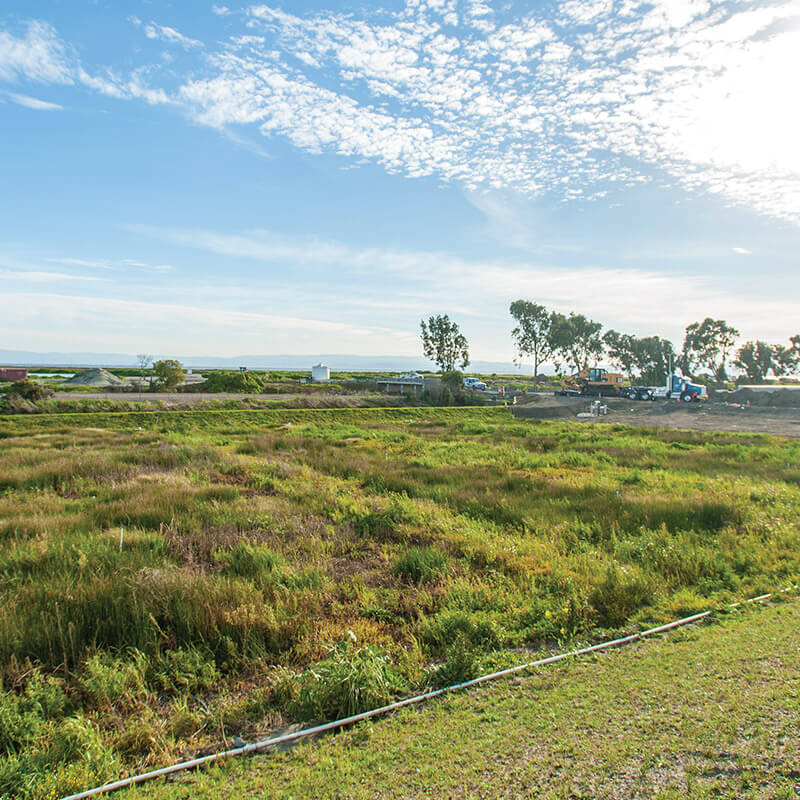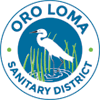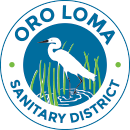See the first of several anticipated peer-reviewed scientific research papers assessing treatment capacity of this innovative system.
A horizontal levee is a re-imagining of how a levee looks and what it can do. Instead of a vertical wall to protect against storm surges, a horizontal levee uses vegetation on a slope to break waves. The ecosystems that live on horizontal levees can thrive while helping to further polish the clean water from wastewater treatment plants. An experimental horizontal levee was established at Oro Loma and Castro Valley Sanitary Districts in 2015. Since that time, a team from UC Berkeley has studied the Horizontal Levee’s ability to polish the water. Dr. Aidan Cechetti published a paper on several years’ worth of his research on the Horizontal Levee. The abstract and link below provide all the details on the research findings.
One of the main conclusions is that when flow remains within the soil layer, treatment is near complete. When water runs over the top of the surface, little treatment occurs.
The Horizontal Levee: a multi-benefit nature-based treatment system that improves water quality and protects coastal levees from the effects of sea level rise.
Authors: Aidan R. Cecchetti, Angela N. Stiegler, Katherine E. Graham, David L. Sedlak
* a Department of Civil and Environmental Engineering, University of California, Berkeley, CA, 94720, USA Department of Civil and Environmental Engineering, Stanford University, Stanford, CA, 94305, USA c US National Science Foundation Engineering Research Center (ERC) for Re-Inventing the Nation’s Urban Water Infrastructure (ReNUWIt), USA

Research Abstract:
Municipal wastewater treatment plants in coastal areas are facing numerous challenges, including the need to provide a cost-effective approach for removing nutrients and trace organic contaminants from wastewater, as well as adapting to the effects of climate change. The horizontal levee is a multi-benefit response to these issues that consists of a sloped subsurface treatment wetland built between a coastal levee and tidal marshes. The wetland attenuates storm surges and can provide space for wetland transgression to higher elevations as sea levels rise, while simultaneously removing contaminants from treated wastewater effluent. To assess the ability of the horizontal levee to improve water quality and to identify optimal operating conditions, a 0.7-ha experimental system was studied over a two-year period.
The removal of nitrate and trace organic contaminants was particularly sensitive to hydrology; rapid and near complete removal (>97%) of these contaminants was observed in water flowing through the subsurface, whereas surface flows did not exhibit measurable contaminant removal.
Removal of Fþ coliphage also appeared to be sensitive to hydrology, with up to 99% removal of these indicator viruses in subsurface flow. For phosphate, removal was not as sensitive to hydrology, but significant removal (>83%) was still observed when overland flow was eliminated. Although removal of contaminants did not appear to be sensitive to other design considerations, parameters such as soil texture and planting regimes affected the maximum subsurface flows, which in turn controlled contaminant mass loadings. Rapid subsurface removal of contaminants suggests that water quality benefits of these systems are limited by physical constraints (i.e., the ability of the system to maintain subsurface flow) and not chemical or biological conditions in the subsurface. © 2020


